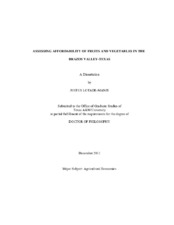| dc.description.abstract | The burden of obesity-related illness, which disproportionately affects low income households and historically disadvantaged racial and ethnic groups, is a leading public health issue in the United States. In addition, previous research has documented differences in eating behavior and dietary intake between racial and ethnic groups, as well as between urban and rural residents. The coexistence of diet-related disparities and diet-related health conditions has therefore become a major focus of research and policy. Researchers have hypothesized that differences in eating behavior originate from differing levels of access to and affordability of healthy food options, such as fresh fruits and vegetables. Therefore, this dissertation examines the affordability of fresh produce in the Brazos Valley of Texas.
This study uses information on produce prices collected by taking a census of food stores in a large regional area through the method ground-truthing. These are combined with responses to a contemporaneous health assessment survey. Key innovations include the construction of price indices based on economic theory, testing the robustness of results to different methods of price imputation, and employing spatial econometric techniques.
In the first part of the analysis, I evaluate the socioeconomic and geographical factors associated with the affordability of fresh fruits and vegetables. The results based on Ordinary Least Squares (OLS) regression show that except housing values (as median value of owner-occupied units) and store type, most factors do not have significant effects on the prices for these food items. In addition, the sizes and signs of the coefficients vary greatly across items. We found that consumers who pay higher premiums for fresh produce reside in rural areas and high proportion of minorities neighborhoods. We then assess how our results are influenced by different imputation methods to account for missing prices. The results reveal that the impacts of the factors used are similar regardless of the imputation methods. Finally we investigate the presence of spatial relationships between prices at particular stores and competing stores in the neighborhoods. The spatial estimation results based on Maximum Likelihood (ML) indicate a weak spatial correlation between the prices at stores located near each others in the neighborhoods. Stores selling vegetables display a certain level of spatial autocorrelation between the prices at a particular store and its neighboring competitors. Stores selling fruits do not present such relations in the prices. | en |


